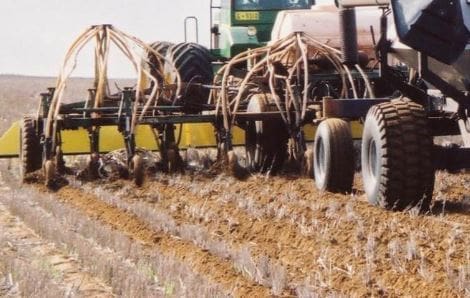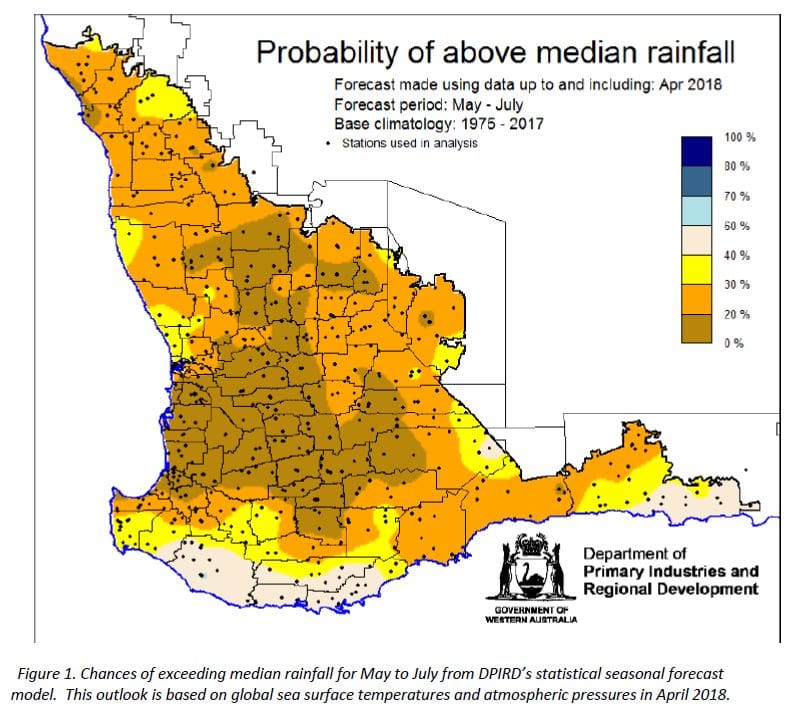DRY conditions continue to keep a lid on Western Australian winter crop seeding programs, prompting analysts to revise downwards the likely area of canola, oats and lupins, but lift the potential area of barley.
 In its May report released today, the Grain Industry Association of Western Australia (GIWA) estimates the state will plant around 8.264 million hectares (Mha) of winter crop this year, up from 7.826Mha last year.
In its May report released today, the Grain Industry Association of Western Australia (GIWA) estimates the state will plant around 8.264 million hectares (Mha) of winter crop this year, up from 7.826Mha last year.
Wheat will remain the dominant crop at a projected 4.85MHa. The barley area is likely to surge to 1.53Mha, overtaking canola which has been reduced 15.2 per cent on April estimates to now be at 1.2Mha.
GIWA Oilseeds Council chair, Michael Lamond, said isolated pockets of early sown canola, lupin and, to a lesser extent, cereals were up in the eastern, south coastal and Esperance regions with most paddocks patchy due to the lack of follow up rain.
He said a severe wind event last week caused widespread damage to emerged crops and paddocks where stubble was not anchored in the southern regions.
“A lot of growers in that area cut the stubbles fairly long last harvest trying to get the crop off because of the moisture. Anyone who has gone through and stubble crunched or burnt chaff lines, they just blew. It might only be five per cent of the paddock, but it is a visual thing that makes it look worse,” he said.
“A lot of the crops that were up were sand blasted and buried in the furrows. It is mainly the canola. It was only a small area of canola that was up on moisture.”
Barley expansion
Mr Lamond said the area of canola in WA would be down from last year due to the lack of rain and lateness for sowing the crop.
Many paddocks initially earmarked for canola will now be switched to barley. As a result, the estimated barley area has increased.
“Once you get to the end of May, growers will have swapped over the few paddocks they had up their sleeves to cereal,” he said.
“As soon as it gets to look like it could be a negative profit margin they forego the break crop for something that will hopefully deliver cash. One of the best ones at the moment is barley. The price is holding up.
“Although the wheat price has kicked a little, barley will generally out-yield wheat. So that is why the area of barley has gone up.
“There are reports of a lack of barley seed supply. You know when that happens there is an extra area going in.”
Mr Lamond said the area growing barley would spread further this year with expansion in the northern cropping area.
“There is more barley projected to be planted in the north this season. Only a few years ago they didn’t have bin segregations up there,” he said.
Mr Lamond said it was too early to call what the wheat area would be in WA this year with plenty of time left for planting and uncertainty over what the rainfall patterns would do.
“There is still a long way to go for wheat. Most growers aren’t overly worried at the moment, but once it gets to the first week in June they will start to get a bit edgy if there is no rain in sight,” he said.
“Most growers will be holding back 20 to 30 per cent of their program until the end of May to see what happens.”
Rainfall outlook
WA Department of Primary Industries and Regional Development research officer, Ian Foster, said the seasonal rainfall outlook from DPIRD’s statistical model for May to July showed a clear preference towards drier than normal conditions (see Figure 1).
He said about half of Australian and international climate models were also indicating May to July rainfall is likely to be lower than the long term median. Beyond that period, the risk of below average seasonal rainfall remained during winter.
In the shorter term, May rainfall appeared highly likely to be below average with weather models indicating little or no rain for the next 10 days or more.
Opportunities for early crop emergence may be limited except in areas where patchy rain in early May has provided soil moisture. Temperatures have been above average for the month so far.
 The Bureau of Meteorology seasonal outlook summary for May to July indicates:
The Bureau of Meteorology seasonal outlook summary for May to July indicates:
- Below average rainfall is likely for parts of southwest Australia and western Victoria, but for much of the country there is little shift towards a wetter or drier than average period.
- May to July daytime temperatures are likely to be warmer than average for southern Australia and the northern Kimberley in WA.
- May days and nights are very likely to be warmer than average for much of the country.
- The El Niño – Southern Oscillation (ENSO) in the tropical Pacific Ocean is neutral (neither El Niño nor La Niña) and is expected to remain neutral through the coming season. The Indian Ocean Dipole (IOD) is also neutral, with the possibility of a negative IOD event forming during winter. With mostly neutral climate drivers at present, there is no strong push towards broadscale wetter or drier conditions across the country.
View the full GIWA May 2018 crop report: http://www.giwa.org.au/2018
Grain Central: Get our free daily cropping news straight to your inbox – Click here



HAVE YOUR SAY